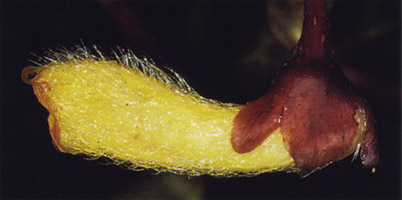
Glossoloma hertae (Mansf.) J.
L. ClarkGesneriads 56 (3): 22 (2006)
Full name and orig. publication: Glossoloma Hanst., Linnaea 26: 191, 208, 209 (April 1854, "1853").
Etymology: Composed of the Greek γλωσσα, glōssa = tongue, and λωμα, lōma = (border, margin), limb, alluding to the tongue-like, undivided lower lip of the corolla.
Synonyms: -
Infrafamilial position: Gesnerioid Gesneriaceae (Gesnerioideae) - Episcieae.
Description: Terrestrial (rarely epiphytic) subshrubs or coarse herbs with fibrous roots. Stems terete or quadrangular. Leaves opposite, ± isophyllous, petiolate, lamina elliptic to ovate, margin entire or serrate, secondary venation rather conspicuous when dry. Cymes axillary, 1- to 3-flowered, bracteolate. Flowers densely crowded or solitary, resupinate, peduncle ± absent. Sepals nearly free, green or colored, broadly ovate, entire to strongly serrate, pubescent or pilose. Corolla oblique to horizontal in the calyx, tubular and usually ampliate, yellow or red, constricted at the throat, base gibbous, often ventricose below the mouth, limb of usually 5 small lobes. Stamens 4, included; filaments adnate to base of corolla tube; anthers transversely oblong, coherent or becoming free, dehiscing by longitudinal slits. Nectary a 2-lobed (rarely single-lobed) gland. Ovary superior, style included. Fruit a fleshy bivalved capsule surrounded by the persistent calyx. Seeds numerous, longitudinally striate.
Chromosome number: 2n = 18.
Species number: Over 20.
Species names (incl. publication and synonyms): See Skog, L.E. & J.K. Boggan. 2005: World checklist of Gesneriaceae: http://persoon.si.edu/Gesneriaceae/Checklist.
Type species: Glossoloma tetragona Hanst.
Distribution: From southern Mexico to northwestern South America, south to Bolivia.
Ecology: Terrestrial (rarely epiphytic); growing in moist and wet forests, mostly at higher elevations.
Notes: Essentially based on molecular data, Glossoloma was recently re-established by J.L. Clark (see Clark 2005, Clark et al. 2006) for a number of species hitherto referred to Alloplectus Mart. The most conspicuous feature of the genus is the resupination (upside-down-orientation) of the flowers. Other characteristic features include terrestrial habit, ± isophyllous leaves, terminally pouched flowers, longitudinal dehiscence of the anthers and fleshy capsules. The genus is related to Alloplectus, Crantzia, Drymonia and Columnea s.l. A revision of Glossoloma is in preparation (J.L. Clark, pers. comm.). The only species in cultivation seems to be G. herthae (Mansf.) J.L.Clark from Ecuador (Clark 2006).
Selected references: Clark, Skog & Salinas, Novon 15: 70-79 (2005), new spp. of Alloplectus, some later transferred to Glossoloma;Clark, Selbyana 25: 182-209 (2005), rev. of Alloplectus; Clark, Herendeen, Skog, Zimmer, Taxon 55: 313-336 (2006), molec. syst.; Clark, Gesneriads 56(3): 20-25 (2006), surv.
Clark, Skog & Salinas, Novon 15: 70-79 (2005), new spp. (some later transferred to Glossoloma);
Bibliography: See Skog, L.E. & J.K. Boggan. 2005. Bibliography of the Gesneriaceae. 2nd edition: http://persoon.si.edu/Gesneriaceae/Bibliography.
Illustrations:
 |
Glossoloma hertae (Mansf.) J. L. ClarkGesneriads 56 (3): 22 (2006) |
last modified: 2007-07-13